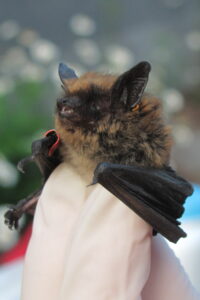Eastern Small-footed Bat
Scientific Name: Myotis leibii
Description.
Eastern small-footed bat is the smallest bat in the eastern US, typically weighing between 3 to 6 grams. The wingspan is around 210-250 mm. Though it can be difficult to distinguish bats in the genus Myotis, the eastern small-footed bat has several characters that aid in an easier identification. Their fur is dark brown with burnished bronze tips. The forearm is black; so are the ears and face, giving this species the appearance of wearing a mask. And, as the name implies, this bat has small feet with a length of 8 mm or less. The calcar is keeled.
Distribution.
This species is known from southeastern Canada, through New England and south through the Appalachians into northern Georgia and as far west as the Ozarks. In North Carolina it occurs in the mountainous western region.
Ecology and Behavior.
Not only are eastern small-footed bats identifiable by their small feet compared to other small brown bats, they also have a slower flight and unusual wing motion. They are very active during the summer, changing their roosting location each day. However, they typically return to the same cave each winter to hibernate. Unlike other NC bats, eastern small-footed bats hibernate horizontally rather than vertically and have the shortest hibernation period. Unique to this species, they commonly roost in talus slopes and rock ledges or even under medium-sized rocks on hillsides.
Food and Feeding.
Eastern small-footed bats feed on beetles, moths, leafhoppers, flies, ants, and mosquitoes, and are considered experts at feeding on nocturnal flying insects.
Reproduction and Development.
Mating occurs in late summer to early fall with females being able to store sperm through hibernation. Each female gives birth to a single pup between May and July. It is believed eastern small-footed bats only give birth to one pup each season due to the newborn’s large size at birth. Eastern small-footed bats form maternity colonies that are usually between 12 and 33 individuals and females are solely responsible for caring for offspring.
Status.
The listing of the eastern small-footed bat’s status varies depending on the specific location being examined within their range. Overall, they are of “special concern” as a result of White-Nose Syndrome and human activity such as logging and agricultural development.
- Click here to see where you can find the Eastern Small-footed Bat in NC!
